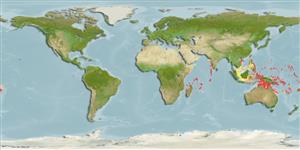Common names from other countries
Environment: milieu / climate zone / depth range / distribution range
Écologie
marin récifal; profondeur 1 - 55 m (Ref. 27115), usually 1 - 35 m (Ref. 90102). Tropical; 22°C - 28°C (Ref. 27115); 19°N - 22°S
Indo-Pacific: Aldabra and Astove of Seychelles to the Loyalty Islands, Fiji and Japan. Report from southern Marshall Islands appears to be based on the paratype of Luzonichthys robustus Fourmanoir, which has been reidentified as Luzonichthys earlei (Ref. 8524).
Taille / Poids / Âge
Maturity: Lm ? range ? - ? cm
Max length : 7.0 cm TL mâle / non sexé; (Ref. 2334)
Épines dorsales (Total) : 10; Rayons mous dorsaux (Total) : 15 - 16; Épines anales: 3; Rayons mous anaux: 7. Looks blue with dark yellow over the back when seen in natural light. Unlike most other basslets, the dorsal fins are in two parts (Ref. 48635).
Usually in groups on outer reef slopes (Ref. 27115). Most commonly occurs in shallow water and most likely seen by divers (Ref. 37816). Forms dense aggregations that feed on zooplankton (Ref 90102).
Life cycle and mating behavior
Maturities | Reproduction | Spawnings | Egg(s) | Fecundities | Larves
Randall, J.E. and J.E. McCosker, 1992. Revision of the fish genus Luzonichthys (Perciformes: Serranidae: Anthiinae), with descriptions of two new species. Indo-Pac. Fish. (21):21 p. (Ref. 8524)
Statut dans la liste rouge de l'IUCN (Ref. 130435)
CITES (Ref. 128078)
Not Evaluated
Menace pour l'homme
Harmless
Utilisations par l'homme
Pêcheries: commercial; Aquarium: Commercial
Outils
Articles particuliers
Télécharger en XML
Sources Internet
Estimates based on models
Preferred temperature (Ref.
115969): 25.9 - 28.9, mean 27.7 (based on 604 cells).
Phylogenetic diversity index (Ref.
82804): PD
50 = 0.5156 [Uniqueness, from 0.5 = low to 2.0 = high].
Niveau trophique (Ref.
69278): 3.4 ±0.45 se; based on food items.
Résilience (Ref.
120179): Haut, temps minimum de doublement de population inférieur à 15 mois (Preliminary K or Fecundity.).
Fishing Vulnerability (Ref.
59153): Low vulnerability (10 of 100).
